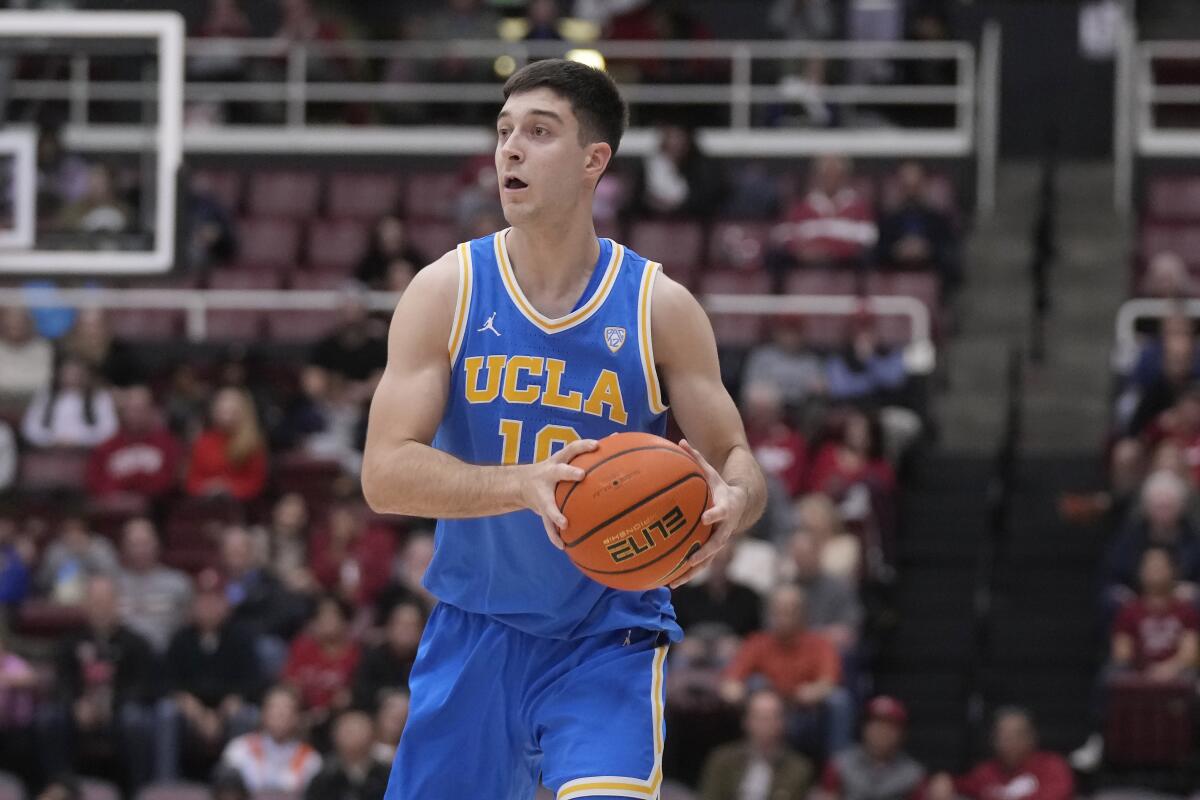When Tyler Bilodeau, Kobe Johnson and the other UCLA starters approach center court for tipoff against Nebraska on Saturday inside Pinnacle Bank Arena, the roars from a sold-out crowd washing over them, one thing will be thunderously clear.
They’re not in Gill Coliseum, Maples Pavilion or any of the other sleepy Pac-12 arenas anymore.
Noise will be a constant companion as UCLA navigates its first Big Ten schedule. Nine conference teams are averaging at least 10,000 fans for home games, with Indiana’s average of 16,514 leading the way. Purdue ranks second with 14,876 fans per home game, followed closely by Nebraska (14,848), Michigan State (14,797) and Illinois (14,789).
“I don’t think I can name a single Big Ten stadium where their fans don’t come and, like, show out and support and they’re talking trash,” said UCLA junior guard Skyy Clark, a veteran of the experience after having spent his freshman season at Illinois. “It definitely gets loud and rowdy, so it’s a fun environment to play in.”
Well, maybe not always for the visitors.
Nebraska (11-2 overall, 1-1 Big Ten) has won 19 consecutive games on its home court during a streak that began in December 2023. With a victory over the No. 15 Bruins (11-2, 2-0), the Cornhuskers would tie the school record of 20 straight home wins they set twice previously.
UCLA coach Mick Cronin understands the challenge that awaits after having taken Cincinnati to Pinnacle Bank Arena in December 2014, when his Bearcats lost in double overtime. At the time, Cronin called the 15,147-seat facility “probably, outside of Louisville, the best arena I’ve ever been in.”
The atmosphere Saturday will certainly be more raucous than what the Bruins experienced in the Pac-12, where some libraries might have been louder than the basketball arenas.
Often it seemed as if the wrestling and basketball banners hanging from the rafters inside Oregon State’s Gill Coliseum outnumbered the fans.
Washington State players once made a habit of venturing into the stands to personally thank fans who showed up inside Beasley Coliseum, the goodwill gesture needing only a few minutes to complete.
UCLA guard Lazar Stefanovic looks to pass the ball during a relatively quiet game at Stanford on Feb. 7.
(Jeff Chiu / Associated Press)
At Maples Pavilion, UCLA blue often eclipsed Stanford red.
“There’s some schools — obviously we’re not in their league anymore — you go play in those places and there’s 1,000 people and it’s cold and you’re paranoid because your guys can’t get going, there’s just no energy in the building,” Cronin said this week.
Arizona was the only Pac-12 team to average at least 10,000 fans for home games during the conference’s final season. Oregon State, Stanford and Washington State averaged fewer than 4,000 fans, with California barely topping that threshold at 4,022.
There will be a carryover effect in the Big Ten given that all four newcomers from the Pac-12 rank in the bottom five in home attendance, with USC’s average of 3,872 the lowest and UCLA ranking next to last with an average of 4,830.
UCLA guards Kobe Johnson (0), Lazar Stefanovic (10), Dylan Andrews (2) and Skyy Clark (55) celebrate beating Gonzaga at the Intuit Dome in Inglewood on Dec. 28.
(Allen J. Schaben / Los Angeles Times)
The Bruins can expect more than double those figures almost every time they board a plane for the Midwest or the East Coast.
“In those college towns,” Cronin said, “it’s the only show in town, so they get great attendance. … So the energy won’t be a problem in the building in those places. You better play with toughness, you better travel your defense because teams with home crowds like that tend to play harder and I think it’s fool’s gold to think you’re going to go into those type of places and score 80 points.”
The Bruins might also want to pack their winter coats. The forecast for Lincoln, Neb., on Saturday calls for a high of 24 degrees, giving Cronin a chance to use the ski mask and gloves his brother, Dan, bought him for Christmas.
“I was like, ‘Yo, man, I live in Southern California,’ ” Mick Cronin said, “and he’s like, ‘You’re in the Big Ten.’ How about that? The guy’s a comedian.”
Injury updates
UCLA’s Eric Dailey Jr., wearing a face mask, relishes the moment after making a three-pointer against Gonzaga at the Intuit Dome on Dec. 28.
(Allen J. Schaben / Los Angeles Times)
Cronin said forward William Kyle III was probably out for the game against Nebraska but could return as soon as Tuesday against Michigan after undergoing surgery for an undisclosed condition.
Forward Eric Dailey Jr. is expected to wear a mask “for the foreseeable future” after absorbing a shot to the face against North Carolina last month, Cronin said.
In his first game wearing the mask, against Gonzaga, Dailey made four of five three-pointers. “He may not take it off the rest of the year,” Cronin cracked.
Etc.
Former UCLA forward Berke Buyuktuncel is averaging 7.9 points and a team-leading 6.6 rebounds in his first season at Nebraska. “I’m happy for him,” Cronin said. “He’s definitely gotten stronger and I think he fits into what they do.” Bruins forward Lazar Stefanovic said he looked forward to reuniting with his former roommate. “The thing I loved about him was when we would play video games, he would make, like, all the jokes and stuff and everybody in the apartment would have a lot of fun with it,” Stefanovic said. “And he was good at video games.” … UCLA made 42.9% of its three-pointers in December, raising its accuracy from long range for the season to 37.1%. “The advantage we have in our starting lineup,” Cronin said, “is everybody can shoot.”
